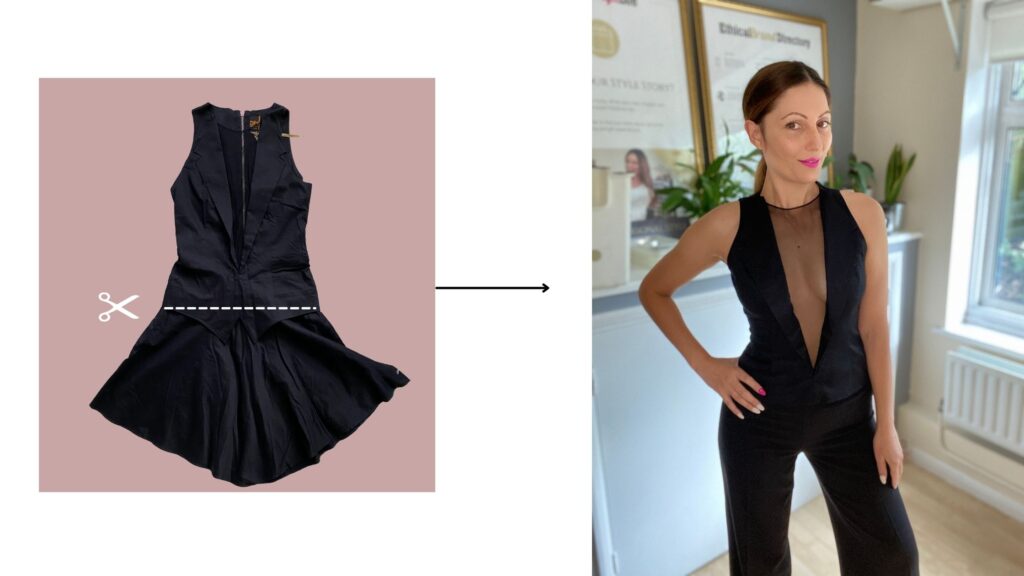If you’ve ever considered an personal style makeover, I would recommend you explore a sustainable styling makeover instead. It not only saves you money but the entire approach is more focused on styling not shopping.
What do sustainable personal stylists do?
Sustainable stylists like myself have an emphasis on being resourceful and kinder to the planet, supporting quality over quantity.
For those who are truly invested in promoting a slower, more sustainable lifestyle (yep, that’s me) the emphasis is on utilising your existing wardrobe and garments that are already in circulation. I am a huge advocate of care and repair services, and over the last 3-4 years it’s been great to see the rise in the number of services popping up across the UK.
I work with my clients to help reimagine their clothes through upcycling and alterations, and this is where the majority of the ‘shopping’ budget will go.
This approach is much more focused on the creative styling process rather than shopping for new items. When you opt for a sustainable style of makeover, you will learn more about your own body shape, the perfect colours and materials, in a way that is very different to shopping for new items.
Isn’t a sustainable stylist a contradiction?
Ah, yes, this is the great debate! I do agree that the term sustainable fashion, as well as a sustainable fashion stylist can be oxymoron. That is, if you conclude that all sustainable stylist are also personal shoppers, and perhaps content creators, that gain financial gains from the promotion of new clothes via affiliate links with brands.
Can a stylist ever be sustainable?
If you work with a Sustainable Stylist like me we will always explore preloved and vintage first if you do need to shop for new items. Then we might explore independent ethical and sustainable brands instead of hitting the mainstream shops on the high-street.
However, my main focus since I set up my styling business in 2016 has always been sustainable styling, which I defined as making the most out of your existing clothes. Like all stylists I do offer many services, but the message remains the same for me… how can I empower more women. My vision has always been to make sustainable style the new norm.
Main benefits of sustainable styling

Why should you choose sustainable styling?
- It’s a much more cost effective way to create a high-end looking style because we focus on the perfect fit
- Sustainable style makeovers focus on alterations, modifications and breathing new life into old pieces
- It’s more meaningful, there’s a lot of emotional connection and history in our wardrobes, sustainable styling is about taking something you love, but don’t get enough wear from it, and making it work for you and your current lifestyle
- You will learn lots of styling tricks and be able to have much more fun with your existing wardrobe
- You can be proud that you have a wardrobe that’s aligned with your values
- You can invest in high-quality pieces that are more affordable to buy pre-loved
- You can discover a range of unique styles and pieces when exploring the options by sustainable fashion brand
What is the definition of sustainable fashion?
Sustainable fashion is a term describing how fashion garments are made and the processes, activities, and people associated with it. The goal of sustainable fashion is to help reduce the negative impact that the fashion industry has on the planet and the people who make our clothes, and/or are affected by textile production in the area they live . Sustainable fashion isn’t just about reducing the carbon footprint associated with the creation of the textiles, or the longevity of garments – it also includes the welfare of people, animals and the planet.
Sustainable fashion in practice
- Ultimately knowing your personal style is the key to being able to be sustainable with fashion
- Wearing your existing clothes for extended periods of time and aiming for #100wears + from every item
- Outfit repeating and restyling
- Mending and modifying what you already own
- Utilising professional alterations and repairs services
- Understanding how to extend the life of your clothes (care and maintenance)
- Shopping vintage and preloved
- Participating in clothing swaps
- Occasional renting
- Buying recycled, upcycled & redesigned pieces
- Investing in high quality and evergreen designs. …
- Investing in custom made pieces
- Buying from fashion brands that have clear ethical and sustainable practices in place, they produce garments that last, they minimise their impact on the planet during the creation process and they ensure that they take care of the people who make the clothes.
Conclusion: why sustainable styling is better for everyone

When you create a style with sustainability principles in mind- you make a statement about who you are and what you believe in. It’s empowering and has a massive positive impact on the planet.
Every time a garment is saved from landfill, and a garment’s use is extended for for 9 months of active use, this reduces the carbon, water and waste footprints (when compared to purchasing new) by around 20–30% each
Source of data: WRAP
You no longer need to compromise on style because there are plenty of places to shop for preloved clothes now, you no longer need to own cocktail dresses or fancy frocks, as fashion rental has turned mainstream. Even Ethical Fashion has turned a corner.
There are a lot more stylish brand out there, and many of these believe that sustainability is a fundamental part of being an ethical brand, so not only are there more options to buy clothes now that respect people, but also many options out there that are kinder to the planet too. If you need some ethical fashion inspiration look no further than Ethical Brand Directory, a little something I put together back in 2017 for my clients who were interested in wearing their values.

First published 11 September 2017 and updated again in March 2023


